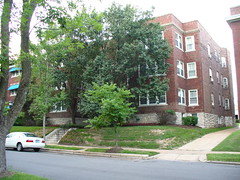I’m visiting St.Louis for the rest of this week to work with our collaborators on acquiring some OCT data. We’re imaging a right-ventricular free wall from a rabbit heart, on the endocardial side, as shown in this picture:
After we were done with work for the day, I took a walk over to the apartment building where most of our lab lived during the hurricane. It was really surreal. On the one hand, all of the Katrina Evacuation, the flooding, the return to New Orleans, etc… feels like a dream. Sometimes I almost believe it didn’t happen, though of course I know it did. And yet, here’s a reminder:
We had some good times during our short stay there, and it helped to build camaraderie and cohesion in the lab. We had the whole top floor of that building (two floors) and once even made use of the roof. Shh, don’t tell Quadrangle Housing.

